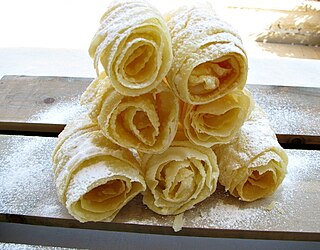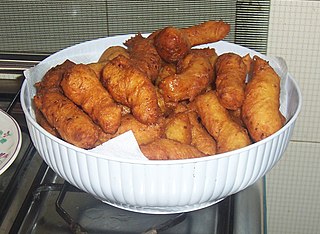
A koeksister is a traditional Afrikaner confectionery made of fried dough infused in syrup or honey. There is also a Cape Malay version of the dish, which is a fried ball of dough that is rolled in desiccated coconut called a koesister. The name derives from the Dutch word "koek", which generally means a wheat flour confectionery.

Bhatoora is a fluffy deep-fried leavened sourdough bread originating from the Indian subcontinent. It is commonly served as a midday meal or a breakfast dish in northern and eastern India. Paired with chickpea curry, it forms a traditional dish called chole bhature which originated in Punjab.

Tulumba or Bamiyeh is a deep-fried dessert found in Turkey and the regional cuisines of the former Ottoman Empire. It is a fried batter soaked in syrup, similar to jalebis and churros. It is made from unleavened choux pastry dough piped with a pastry bag using an open star or similar tip. It is first deep-fried to golden colour and then sugar-sweet syrup is poured over it when still hot. It is eaten cold.

Sausage bread is an American food made of sausage and other ingredients rolled or enclosed in dough and cooked in an oven.

Teiglach, also spelled taiglach or teglach are small, knotted pastries boiled in a honeyed syrup. They are a traditional Ashkenazi Jewish treat for Rosh Hashana, Sukkot, Simchat Torah, and Purim.

Streuselkuchen, also known in English-speaking countries as crumb cake, is a cake made of yeast dough covered with a sweet crumb topping referred to as streusel. The main ingredients for the crumbs are sugar, butter, and flour, which are mixed at a 1:1:2 ratio. The recipe allegedly originated in the region of Silesia, and is popular in German, Polish and Ashkenazi Jewish cuisines.

Gosh-e fil is a fried pastry from Iranian cuisine and also popular in Afghanistan. The dough is shaped like an elephant ear (goosh), and deep-fried in oil. Each piece is then topped with chopped pistachios and powdered sugar.

A pastry blender, or pastry knife, is a cooking utensil used to mix a hard (solid) fat into flour in order to make pastries. The tool is usually made of narrow metal strips or wires attached to a handle, and is used by pressing down on the items to be mixed. It is also used to break these fats into smaller pieces. The blending of fat into flour at this stage impacts the amount of water that will be needed to bind the pastry into a dough.

Khuushuur is a meat pastry that is popular in Mongolia, which is similar to recipes in Russian and other cuisines like chiburekki. It's a circle of wheat flour dough folded in half around a filling of minced or ground beef, mutton, or camel, and ground up or deep fried. The seasoning of the meat is with onion and salt and once served, Khuushuur can be enjoyed as is or accompanied by ketchup or Maggi sauce. Aside from the traditional meat-filled version, there are alternative preparations of Khuushuur. Some variations replace the meat filling with carrots, cabbage, or mashed potatoes. However, vegetarians should be aware that these vegetable versions can retain a distinctive taste of mutton due to the use of cooking oil.

Fazuelos, fijuelas, hiuelas, deblas, or orecchie di Ammon are Sephardic Jewish pastries of thin fried dough. In Sephardic tradition, they are eaten at Purim; the Italian name recalls the shape of Haman's ears, similarly to the Hebrew name for hamantashen, oznei Haman.

Semprit is a Southeast Asian sweet snack made of wheat flour, corn starch, custard powder, sugar and margarine. These ingredients are mixed together to become a dough. Next, the dough is rolled and cut into small pieces, which are baked until golden yellow. Semprit is ready to eat once it has cooled to room temperature.

Dabby-Doughs are a type of pastry. They are traditionally made using the remnants of dough leftovers from making a pie, although they can be prepared in large amounts by simply making a batch of pastry dough. The filling of a dabby-dough is typically a mixture of cinnamon and white sugar sprinkled on butter or margarine, rolled, sliced and baked.

A zippula is a fried dough made to a recipe from Calabria, Italy. Zippuli are made with flour, water, yeast, boiled potatoes, and a pinch of salt. There are many variations: often anchovies are added, but salt cod, stockfish, cheese, sun-dried tomatoes, olives, or 'nduja may also be added.
Gogoși, known as pancove in Transylvania and pampuște in Bukovina, are Romanian sweet pastries similar to filled doughnuts. Gogoși is the plural form of the Romanian word gogoașă.

Shelpek is a traditional Central Asian flatbread commonly consumed all over the region. The main ingredients of shelpek are flour, milk, sugar, butter, sour cream such as Kaymak, baking soda, salt and vegetable oil.

A tahini roll or tahini bread roll is a sweet pastry found commonly in the cuisines of Arab countries, Armenia, Cyprus, Greece and Turkey.

Kue kembang goyang or kuih loyang is an Indonesian cuisine and Malaysian cuisine flower-shaped traditional snack (kuih), associated with Betawi cuisine and Malay cuisine.

Inuliata is a Corsican cake generally shaped as a circle, made of yeast dough. The cake is typical of the cuisine of Corsica and originates from the city of Ajaccio in Corse-du-Sud. Inuliata is prepared during the Easter week.

Timphan or timpan is a steamed banana dumpling, a traditional kue specialty of Aceh, Indonesia usually served during Eid or other special occasions. Ingredients to make timphan consists of glutinous rice flour, ground banana and coconut milk. All of this materials are then mixed and stirred until a thick as a dough. The banana-rice flour dough is spread lengthwise and then it filled with sweetened serikaya or grated coconut mixed with sugar. Then the dough is wrapped in banana leaves and steamed for an hour.

Chinese flaky pastry is a form of unleavened flaky pastry used in traditional Chinese pastries that are invariably called subing. There are two primary forms, Huaiyang-style (淮揚酥皮) and Cantonese-style pastry (廣式酥皮). Huaiyang-style pastry is used to make delicacies such as Shanghainese 'crab shell' pastries (蟹殼黃) while Cantonese-style pastry is used to make pastries like sweetheart cakes.


















